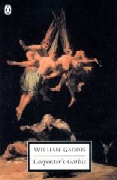|
|
Annotations to Carpenter's Gothic Chapter 1 by Steven Moore except as [noted] | |
| Carpenter's Gothic |
title]
Carpenter’s Gothic: an
architectural style (often “carpenter gothic,” as at 123.36) popular
the US and Britain during the Gothic Revival period of the mid-19th to mid-20th centuries. It has been described as "the most visually playful and lively of all American
architectural styles.” (Montgomery, G.. Storybook Cottages: America’s Carpenter Gothic Style. New York: Rizzoli, 2011.) McCandless’s
description is on pp. 227-28 below.
|
|
| Abbreviated
References |
Chapter 1 1.1]
dove: traditional
symbol of peace, and in Christian iconography a representation
of the Holy Spirit.
1.12]
that time of day: CG
was originally
entitled “That Time of Year,” after the opening line of Shakespeare’s
Sonnet 73, which is alluded to throughout the novel.
2.10]
McCandless: referent,
if any, unknown. (There is an Angus McCandless in Malcolm Lowry’s posthumous
novel October Ferry to Gabriola,
but it is highly unlikely the name came from there.)
2.12]
Rio? Isn’t that Argentina?: Rio
de Janeiro is in Brazil, of course, but it’s worth noting early that
mis-/disinformation is a major theme in CG
and consequently the novel is filled with mistakes like this one. 2.28]
9W: Manhattan’s
Broadway becomes highway 9 after the Washington Bridge and runs north
along the Hudson River to Croton-on-Hudson (the novel’s setting) and
beyond. 3.18]
Plattsburgh:
in the upper NE corner of New York State. 6.24]
Longview: also
the hometown of the Gablers: see 184.8. 10.11]
Mister Ude: a
name first used in J R for
a judge of the Surrogate Court on whom Governor Cates relies for favors
(101, 211) and who dies near the end of the novel (691). Amy Joubert
went to school with Judge Ude’s daughter (213). 13.10]
Payne Whitney:
a psychiatric clinic on Manhattan’s Upper East Side, which largely catered
to those from well-to-do families. (Cf. FHO
43.9) 13.13]
folded up all your clothes and put them in the refrig... [...] something
you read someplace: Liz
read this in The Recognitions,
where Arnie Munk is described as having once done this (175). 15.4]
Doctor Kissinger: after
Henry Kissinger (1923-2023 )
the former Secretary of State and author.
15.14]
Kitzbühel: resort
town in the Tirol (west Austria). 15.14]
Deauville: town
in NW France on the Bay of the Seine. 16.18]
Eleuthera: island
in the Bahamas. 17.7]
VCR: later identified
as Vorakers Consolidated Reserve. 24.5]
in the paper? these gooks adopting dogs and eating them?: like
most references to newspaper stories in CG, probably based on an actual article in the New York Times.
|
|
| Carpenter's Gothic |
||
|
|
||
